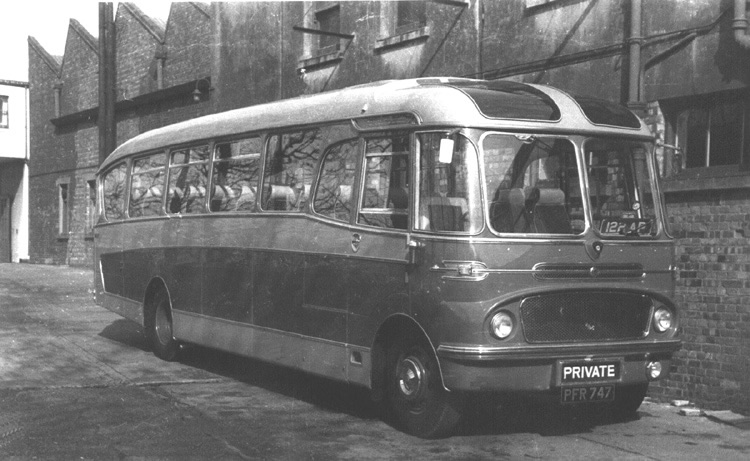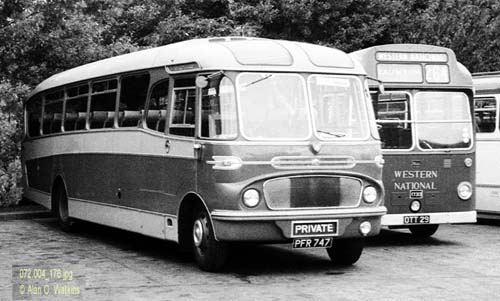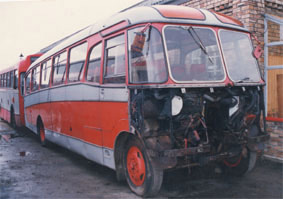
Above: PFR 747 with Harrington trade plates outside Sackville Works.
The Harrington Crusader first appeared at the 1958 Motor show although production did not really start until the following year. The first style was to run until late 1960 when the Mark 2 version was introduced. In this comparatively short time, something like 120-150 bodies were made, variously on Bedford SB, Ford Thames and Commer Avenger chassis. Later, a few Mark 1 style bodies were produced to special order even when the Mark 2 had been in production for some time.
 PFR
747 was new to Abbotts of Blackpool in March 1959. It was one of two delivered
- the other was PFR 757. Like all Abbotts coaches the registration numbers
were selected to at least end in a seven. 747 and 757 must have been double
lucky. The chassis numbers were not that close together, being SB 3 67798
for 747 and SB 3 68568 for 757. Despite the gap, the two chassis went to Harringtons
together and gained bodies 2072 and 2073 respectively. Harrington were not
in the habit of reserving body numbers so it can be said with some certainty
that therefore they went out of the door one after the other. As a matter
of interest, the body preceding PFR 747 was VHO 200, a Wayfarer IV, also still
in existence with Thornes of Bubwith. PFR 747 was the 12th Crusader to be
built. The Crusader style took a little time to settle down with regard to
exterior trim detail and it appears that the Abbotts pair were the last ones
to have a Harrington badge fitted to the cover over the radiator cap. The
Bedford badge was mounted on the grille below. On subsequent bodies the Bedford
badge moved up to the radiator cap and the Harrington badge was deleted. Sadly,
but hardly surprisingly, the Harrington badge on PFR 747 has long since disappeared.
PFR
747 was new to Abbotts of Blackpool in March 1959. It was one of two delivered
- the other was PFR 757. Like all Abbotts coaches the registration numbers
were selected to at least end in a seven. 747 and 757 must have been double
lucky. The chassis numbers were not that close together, being SB 3 67798
for 747 and SB 3 68568 for 757. Despite the gap, the two chassis went to Harringtons
together and gained bodies 2072 and 2073 respectively. Harrington were not
in the habit of reserving body numbers so it can be said with some certainty
that therefore they went out of the door one after the other. As a matter
of interest, the body preceding PFR 747 was VHO 200, a Wayfarer IV, also still
in existence with Thornes of Bubwith. PFR 747 was the 12th Crusader to be
built. The Crusader style took a little time to settle down with regard to
exterior trim detail and it appears that the Abbotts pair were the last ones
to have a Harrington badge fitted to the cover over the radiator cap. The
Bedford badge was mounted on the grille below. On subsequent bodies the Bedford
badge moved up to the radiator cap and the Harrington badge was deleted. Sadly,
but hardly surprisingly, the Harrington badge on PFR 747 has long since disappeared.
Abbotts were long established Harrington customers and had been buying since the 1930s. Their business encompassed holiday tours, express long distance and local work such as schools. While the longer distance work required the use of larger luxury coaches on heavy duty chassis, it seems Abbotts believed in horses for courses and bought smaller vehicles for the less arduous local work, which would have included feeders to the tour coaches. It is assumed that these latter duties would have included the Crusaders, especially since the original concept of the design was high passenger capacity with lightweight seats, which were not quite as comfortably upholstered as the usual Harrington seats.
 In 1965 photographer Alan Watkins captured PFR 747 down in
Taunton in Somerset. He noted the owner as Terraneau of North Molton. Like
Abbotts they had a grey and red livery (but unlike Abbotts were not too concerned
that all their should coaches carry it in a uniform fashion). They may have been tempted to the Crusader
purely by the fact that it was already in the right colours. By this time the
bottom of the fibreglass front panel was of a later type than that used on the first Crusaders.
This change concerned the shape of the fibre glass moulding around the destination display, which for the first
few bodies was different depending on the chassis make. As production gained
pace a universal item was developed which could be fitted to all types. Presumably
at some time PFR 747 had an accident and a repair
section was grafted in. Such are the advantages of fibreglass.
In 1965 photographer Alan Watkins captured PFR 747 down in
Taunton in Somerset. He noted the owner as Terraneau of North Molton. Like
Abbotts they had a grey and red livery (but unlike Abbotts were not too concerned
that all their should coaches carry it in a uniform fashion). They may have been tempted to the Crusader
purely by the fact that it was already in the right colours. By this time the
bottom of the fibreglass front panel was of a later type than that used on the first Crusaders.
This change concerned the shape of the fibre glass moulding around the destination display, which for the first
few bodies was different depending on the chassis make. As production gained
pace a universal item was developed which could be fitted to all types. Presumably
at some time PFR 747 had an accident and a repair
section was grafted in. Such are the advantages of fibreglass.
Photo © Alan Watkins.
Please visit Alan's extraordinary record of coaches old and new at Forty Years of Coach Photography
There is no other information to hand regarding PFR 747's further owners or activities. Many so called "light weight" coaches would be expected to have a lifetime not far in excess of 10 years - frequently experiencing rougher and rougher use towards the end. So it was rather surprising to find that by August 1981 PFR 747 had travelled back to the other end of the country and still appeared to be in reasonable condition when it came to rest at Ted Heslops' yard in Hexham. Here it could well have met its end but presumably was deemed too good to scrap. It had lost its petrol engine by the time local man Steve Oliver spotted it in 1990 and decided it was what he wanted for conversion to motor caravan. A Bedford 330 diesel was obtained from Ted and fitted. Technically, this changed PFR from an SB3 to an SB5.
|
Bedford SB engine codes
|
||
| Year | Code | Type |
| 1957 | 1 | Bedford 300 cubic inch diesel |
| 1957 | 3 | Bedford 300 cubic inch petrol |
| 1959 | 8 | Leyland 0.350 diesel |
| 1962 | 5 | Bedford 330 cubic inch diesel |
| 1963 | 13 | Leyland 0.370 diesel |

Taken by Steve Oliver, the photograph left, shows PFR 747 during the engine replacement. At this time it appears to be still in original livery.
Steve fitted out the Crusader for use as a caravan and he, his partner and eventually two children enjoyed many long trips on the coach, including across to the continent. The seats were taken out and stored. When Steve re-located to Wales the seats remained in storage in Newcastle where after a few years someone, thinking they were unwanted moved them out of their storage shed. They suffered so much water damage that they became useless. A very unfortunate turn of events considering Steve had always realised that the coach might one day be restored to original and had tried to minimise irreversable changes with his conversion. Later, one of Steve's friends spotted the seats outside and managed to rescue the "hardware" - the metal frames and the ashtrays.
In 2003 the Crusader was put up for sale, a victim of the usual plight of the preserved bus - loss of storage space. There were a few enquiries, mostly expressing interest in the Bedford chassis for spares.
Considering the Bedford SB is relatively common in preservation, with a Duple or Plaxton body, it was a great surprise to suddenly realise that no other Bedford - Crusader mark 1 appears in the lists of preserved vehicles. In general terms of Harrington production, they had been relatively numerous, but now the type is literally on the brink of extinction. Due to the need to quickly find alternative accommodation and the threat of scrapping for spares, the coach was purchased and became part of the TH Collection. One Crusader Mk1 did turn up later, but in a scrap yard and extensively cannibalised already. It has yielded some spares.
Due to other projects already in progress, there are no immediate plans to start restoration on PFR 747 in the near future. However some work has been done to strip out the internal caravan fittings. Also a number of spares have been "opportunistically" obtained against the day when they will be needed. The original seat frames have been collected from Newcastle. Other spares have included a replacement petrol engine, electrical fittings and most importantly new window rubber. The Crusader has a mixture of rubber sections, the side window being the same as the Cavalier. Unfortunately this is not a stock item (as far as I know - anywhere) and the rubber that was obtained was about the last remaining of a special run organised by some other Harrington owners.
Click on the thumbnails below to enlarge the photographs. They were taken in Wales before moving to Norfolk by low loader. Enquiries from Bedford enthusiasts wishing to assist with the restoration of this vehicle are welcome.









